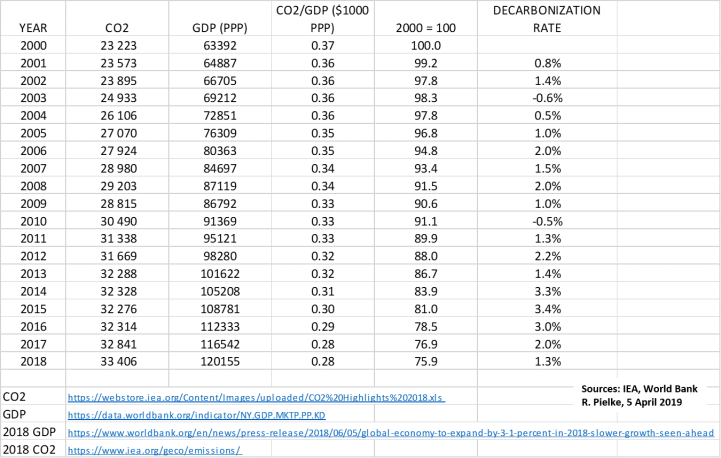
Decarbonization is a technical term that refers to a decrease in the ratio of carbon dioxide emissions to gross domestic product. The concept is derived from the Kaya Identity, which is a very powerful tool for understanding emissions and their potential to be reduced through policy action. This post provides an update on global decarbonization rates, based on new data from the International Energy Agency.
You can read more about the Kaya Identity from Wikipedia. Below is an image from my talks on how we derive decarbonization from the Kaya Identity.

“Technology” refers to technologies of energy production (the “carbon intensity of energy”) and of energy consumption (the “energy intensity of the economy”). Decarbonization thus reflects technological progress associated with the policy goal of reducing emissions. My book The Climate Fix is centered on these concepts.
Data from IEA and the World Bank allow for the calculation of decarbonization 2000 to 2018 that appears at the top of this post. Specifically, the data can be found at:
- 2000-2017 CO2 (xls)
- 2000-2017 GDP PPP
- 2018 GDP
- 2018 CO2
The data show that since 2015, the year that the Paris Argeement was drafted and put forward, the rate of global decarbonization has decreased each year. This is bad news for climate policy. In fact in 2018, based on these data, global decarbonization (1.3%) was less than the 2000-2018 average rate of decarbonization (1.5%).
Here is my simple spreadsheet:


[…] in the ratio of carbon dioxide emissions to GDP. For much of the past two decades, using IEA data, global decarbonization has typically been less than 2% per year, though from 2014 to 2016 it averaged about 3% annually, and from 2010 to […]
LikeLike
[…] in the ratio of carbon dioxide emissions to GDP. For much of the past two decades, using IEA data, global decarbonization has typically been less than 2% per year, though from 2014 to 2016 it averaged about 3% annually, and from 2010 to […]
LikeLike
[…] in the ratio of carbon dioxide emissions to GDP. For much of the past two decades, using IEA data, global decarbonization has typically been less than 2% per year, though from 2014 to 2016 it averaged about 3% annually, and from 2010 to […]
LikeLike
[…] in the ratio of carbon dioxide emissions to GDP. For much of the past two decades, using IEA data, global decarbonization has typically been less than 2% per year, though from 2014 to 2016 it averaged about 3% annually, and from 2010 to […]
LikeLike
[…] in the ratio of carbon dioxide emissions to GDP. For much of the past two decades, using IEA data, global decarbonization has typically been less than 2% per year, though from 2014 to 2016 it averaged about 3% annually, and from 2010 to […]
LikeLike